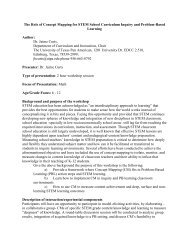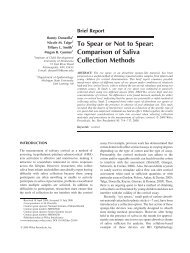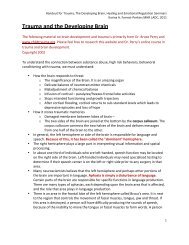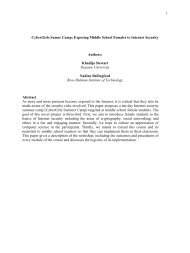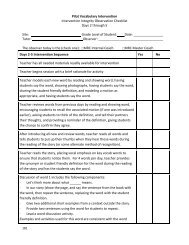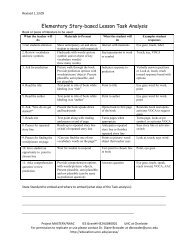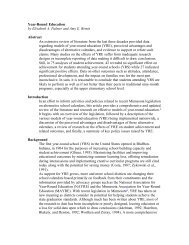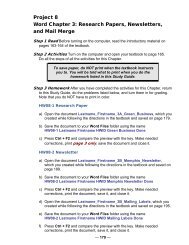Introduction to Positive Ways of Intervening with Challenging Behavior
Introduction to Positive Ways of Intervening with Challenging Behavior
Introduction to Positive Ways of Intervening with Challenging Behavior
Create successful ePaper yourself
Turn your PDF publications into a flip-book with our unique Google optimized e-Paper software.
eginning maintenance <strong>of</strong> a reasonable well-established behavior and can be used when fading out a fixed ratio<br />
schedule. Since it is less systematic or consistent than either continuous or fixed ratio reinforcement variable<br />
reinforcement is not good for teaching a new behavior.<br />
What are interval reinforcement schedules?<br />
When a target behavior is reinforced after a period <strong>of</strong> time, this is referred <strong>to</strong> as an interval reinforcement<br />
schedule.<br />
This schedule is useful for behaviors which can be measured in terms <strong>of</strong> their duration, for example, in-seat<br />
behavior, on-task behavior, etc.<br />
As <strong>with</strong> ratio reinforcement, there are two types <strong>of</strong> interval reinforcement. The first type is fixed interval<br />
reinforcement, which designates a specific interval <strong>of</strong> time, after which reinforcement is delivered contingent on<br />
appropriate behavior. Delivering reinforcement after every five minutes <strong>of</strong> on-task behavior would be an example<br />
<strong>of</strong> fixed interval reinforcement. This is a very systematic and consistent schedule which is excellent for<br />
strengthening a behavior. However, as <strong>with</strong> fixed ratio reinforcement, if reinforcement is simply s<strong>to</strong>pped research<br />
shows that the gains made in behavior will also deteriorate. Variable interval reinforcement is like variable ratio<br />
reinforcement in that reinforcement is delivered after an average length <strong>of</strong> time. This schedule is effective for<br />
already established behaviors and can be used when fading out a fixed interval schedule.<br />
How do I choose a reinforcement schedule?<br />
Recommendations have been given about which types <strong>of</strong> behaviors tend <strong>to</strong> be best reinforced <strong>with</strong> which types <strong>of</strong><br />
schedules. It is likely that you will find ways <strong>to</strong> modify these <strong>to</strong> make them most effective and easily delivered<br />
<strong>with</strong>in your classroom and <strong>with</strong> particular students. What is most important, however, is that you consciously<br />
decide which type <strong>of</strong> schedule <strong>to</strong> use and if it seems not <strong>to</strong> be having an effect, reevaluate it or your functional<br />
analysis.<br />
Choosing the wrong type <strong>of</strong> reinforcement schedule can be detrimental <strong>to</strong> improving behavior. For example, a<br />
student who already possesses a desired behavior in his or her reper<strong>to</strong>ire but simply does not choose <strong>to</strong> exhibit it<br />
will not benefit from continuous reinforcement. He or she may, in fact, learn that manipulating you is possible by<br />
refusing <strong>to</strong> exhibit the behavior unless it is known that you will deliver the desired reinforcement. For such<br />
reasons, it is very important that choosing a schedule <strong>of</strong> reinforcement be an integral aspect <strong>of</strong> your behavior<br />
intervention plan.<br />
Final Note...<br />
It is imperative that the reinforcement delivered is appropriate for each individual student. If what is delivered <strong>to</strong><br />
the student as reinforcement is not preferred by him or her, none <strong>of</strong> these schedules will work. If you are having<br />
problems <strong>with</strong> schedules <strong>of</strong> reinforcement, you may want <strong>to</strong> reevaluate the reinforcement itself. For information<br />
on selecting appropriate reinforcers, please see the tip sheet entitled “<strong>Positive</strong> Reinforcement.”<br />
References<br />
Kerr, M.M., & Nelson, C.M. (1989). Strategies for managing behavior problems in the classroom. 2nd Ed. New York: Macmillan<br />
Publishing.<br />
Zirpoli, T.J., & Melloy, K.J. (1993). <strong>Behavior</strong> management: Applications for teachers and parents. New York: Macmillan Publishing.<br />
This publication was supported by Grant #H029K20171, Special Project <strong>to</strong> Provide Technical Assistance, Inservice Training<br />
and Site Development for <strong>Positive</strong> <strong>Behavior</strong>al Support Strategies for Students <strong>with</strong> Disabilities from the U.S. Department <strong>of</strong><br />
Education. The University <strong>of</strong> Minnesota is an equal opportunity employer and educa<strong>to</strong>r.




